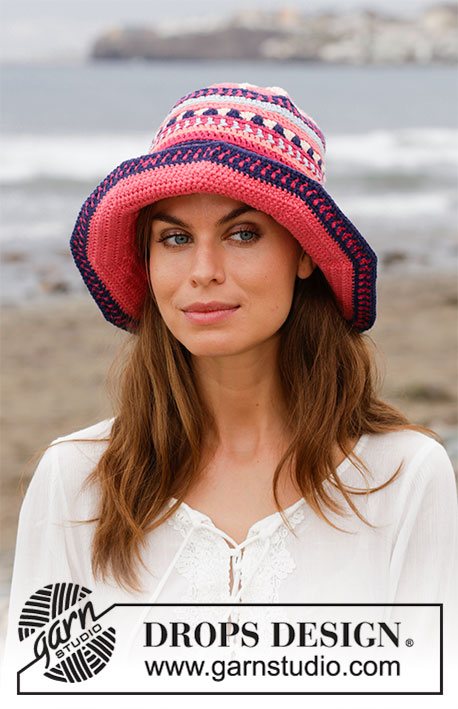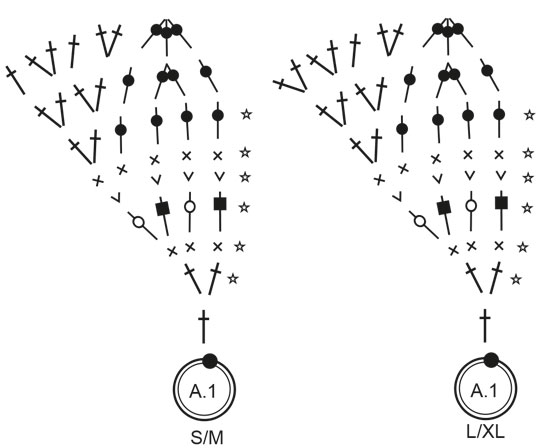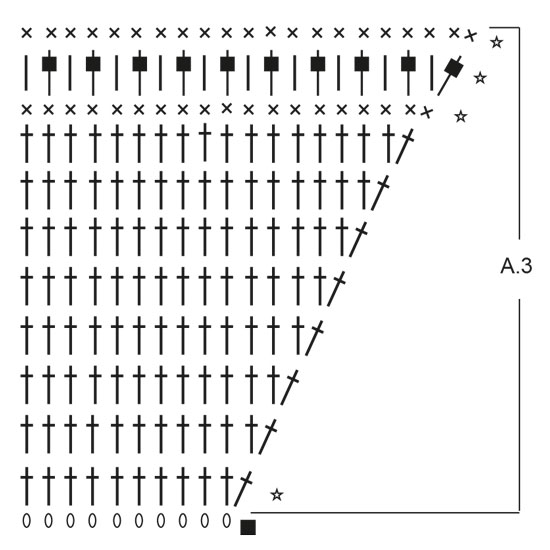Comments / Questions (9)
![]() Christine Hirse Rene wrote:
Christine Hirse Rene wrote:
Hejsa, jeg er ikke så god til diagrammer, jeg har hæklet A1 og alt passer, og skal nu til A2. Den skal hækles i 1:1 maske fra A1, korrekt? Dvs ingen udtag i A2? Tak.
02.07.2024 - 09:26DROPS Design answered:
Hej Christine, ja det stemmer, du hækler A.2 uden udtagninger, så første omgang er 1 fm i hver maske fra sidste omgang :)
03.07.2024 - 07:49
![]() Laura wrote:
Laura wrote:
Buonasera Di questo modello si può avere lo schema con i ferri diritti? Grazie
15.05.2024 - 22:18DROPS Design answered:
Buonasera Laura, questo cappello è lavorato all'uncinetto: se sfoglia il nostro sito può trovare diversi modelli di cappelli lavorati a maglia, tra cui poter scegliere. Buon lavoro!
16.05.2024 - 23:04
![]() Alessandra wrote:
Alessandra wrote:
Grazie comunque; potete invece dirmi il peso medio di un cappello fatto con il filato Paris?
01.05.2023 - 13:49DROPS Design answered:
Buongiorno Alessandra, a questo link può trovare dei modelli di cappelli lavorati con Paris. Buon lavoro!
01.05.2023 - 15:47
![]() Alessandra wrote:
Alessandra wrote:
Per favore vorrei sapere il peso totale del cappello, ho molti avanzi di Paris e vorrei provare ad utilizzarli in questo cappello\\r\\ngrazie
15.04.2023 - 21:25DROPS Design answered:
Buonasera Alessandra, purtroppo non disponiamo di questa informazione. Buon lavoro!
17.04.2023 - 18:41
![]() Vasia wrote:
Vasia wrote:
When doing the S/M version, we have to do A.4 or just A.3? It’s written “0-1 times” and I do not understand how we proceed after A2.
08.03.2023 - 16:30DROPS Design answered:
Dear Vasia, in size S/M repeat A.3 in the round without working A.4 (A.4 applies only in the 2nd size). This means you will crochet 9 times the diagram A.3 in the round, and 1 time in height. Happy croheting!
09.03.2023 - 08:02
![]() Sandra Towers wrote:
Sandra Towers wrote:
Do you have a version of the pattern in children's sizes? Thanks
13.11.2022 - 01:33DROPS Design answered:
Dear Sandra, you can find all of our children's summer hats here: https://www.garnstudio.com/search.php?action=browse&c=children-summer-hats&lang=en.
13.11.2022 - 17:17
![]() Marija Poprocka wrote:
Marija Poprocka wrote:
Hi, there is a mistake in color pattern diagram signs. The last row of A2 symbol "0" is described as SC in heather, while based on the photo it should be ice blue. Thank you.
18.08.2022 - 01:50DROPS Design answered:
Dear Mrs Poprocka, thanks for noticing, the US-English pattern has been edited. Happy crocheting!
18.08.2022 - 09:32
![]() Linda Gaines wrote:
Linda Gaines wrote:
Love the pattern
19.06.2021 - 15:40
![]() Tiffany wrote:
Tiffany wrote:
When are the color changes made? Is there a written version?
14.06.2020 - 13:14DROPS Design answered:
Dear Tiffany, I'm sorry but the explanations are only in diagram format. The colour changes are explained in the abbreviations for the diagram.
14.06.2020 - 22:40
Bazar Hat#bazarhat |
||||||||||||||||||||||||||||||||||||||||||||||
 |
 |
|||||||||||||||||||||||||||||||||||||||||||||
Crocheted hat with multi-colored pattern. The piece is worked in DROPS Paris.
DROPS 190-19 |
||||||||||||||||||||||||||||||||||||||||||||||
|
INFORMATION FOR THE PATTERN: PATTERN: See diagrams A.1 to A.4. Choose diagram for your size (applies to diagram A.1). CROCHET INFO: Each round of double crochets starts with 3 chain stitches (replaces the first double crochet) and finishes with 1 slip stitch in the 3rd chain stitch at the beginning of the round. Each round of single crochets starts with 1 chain stitch (does not replace the first single crochet) and finishes with 1 slip stitch in the first single crochet of the round. Each round which begins by working 3 double crochets together, starts with 3 chain stitches (replaces the first double crochet), skip 1 double crochet on the previous round, work 1 double crochet in the next double crochet, but wait with the last pull through, work 1 double crochet in the next double crochet, pull the strand through all 3 loops on the hook, the round finishes with 1 slip stitch in the 3 double crochets worked together. Some of the pattern will displace the beginning and end of the round. Some of the rounds are worked in the back loop of the stitches from the previous round; see star in diagrams. COLOR PATTERN: When changing color at the beginning of a round, work the slip stitch from the end of the previous round with the new color. When working with more than one color, work as follows: When changing color: Work the last double crochet/single crochet with the first color, but wait with the last pull through, change to the next color and work the last pull through, then work the next double crochet/single crochet. When working with two colors, lay the strand of the color you are not using over the stitches from the previous round and work around the strand so that is hidden and carried forward. Make sure the strand is not tight, either while working or when it is picked up from the previous round. ---------------------------------------------------------- HAT: The piece is worked in the round, top down; i.e. you work from the top of the hat down, working the brim in the round to finish. Work 4 chain stitches with hook size 3.5 mm/E/4 and raspberry and form them into a ring with 1 slip stitch in the first chain stitch. Then work A.1 a total of 12 times in the round – read CROCHET INFO and COLOR PATTERN. REMEMBER THE CROCHET GAUGE! When A.1 has been worked 1 time in height, there are 84-96 stitches on the last round. The increases are now finished. The piece measures approx. 15 cm / 6" in diameter. Work A.2 over all stitches (= a total of 21-24 times). On the last round of A.2 increase 6-3 single crochets evenly on round = 90-99 stitches. When A.2 has been worked 1 time in height, the piece measures approx. 18 cm / 7" from the middle and outwards. Now work the brim as follows: Work * A.3 (= 10 stitches), work A.4 (= 1 stitch) 0-1 time *, work from *-* to end of round (= 9 times in the round). When A.3 and A.4 have been worked 1 time in height, there are 189-207 single crochets on the last round. Cut and fasten the strand. The brim measures approx. 10 cm / 4". |
||||||||||||||||||||||||||||||||||||||||||||||
Diagram explanations |
||||||||||||||||||||||||||||||||||||||||||||||
|
||||||||||||||||||||||||||||||||||||||||||||||

|
||||||||||||||||||||||||||||||||||||||||||||||

|
||||||||||||||||||||||||||||||||||||||||||||||

|
||||||||||||||||||||||||||||||||||||||||||||||

|
||||||||||||||||||||||||||||||||||||||||||||||
Have you finished this pattern?Tag your pictures with #dropspattern #bazarhat or submit them to the #dropsfan gallery. Do you need help with this pattern?You'll find 14 tutorial videos, a Comments/Questions area and more by visiting the pattern on garnstudio.com. © 1982-2025 DROPS Design A/S. We reserve all rights. This document, including all its sub-sections, has copyrights. Read more about what you can do with our patterns at the bottom of each pattern on our site. |
||||||||||||||||||||||||||||||||||||||||||||||



































































Post a comment to pattern DROPS 190-19
We would love to hear what you have to say about this pattern!
If you want to leave a question, please make sure you select the correct category in the form below, to speed up the answering process. Required fields are marked *.